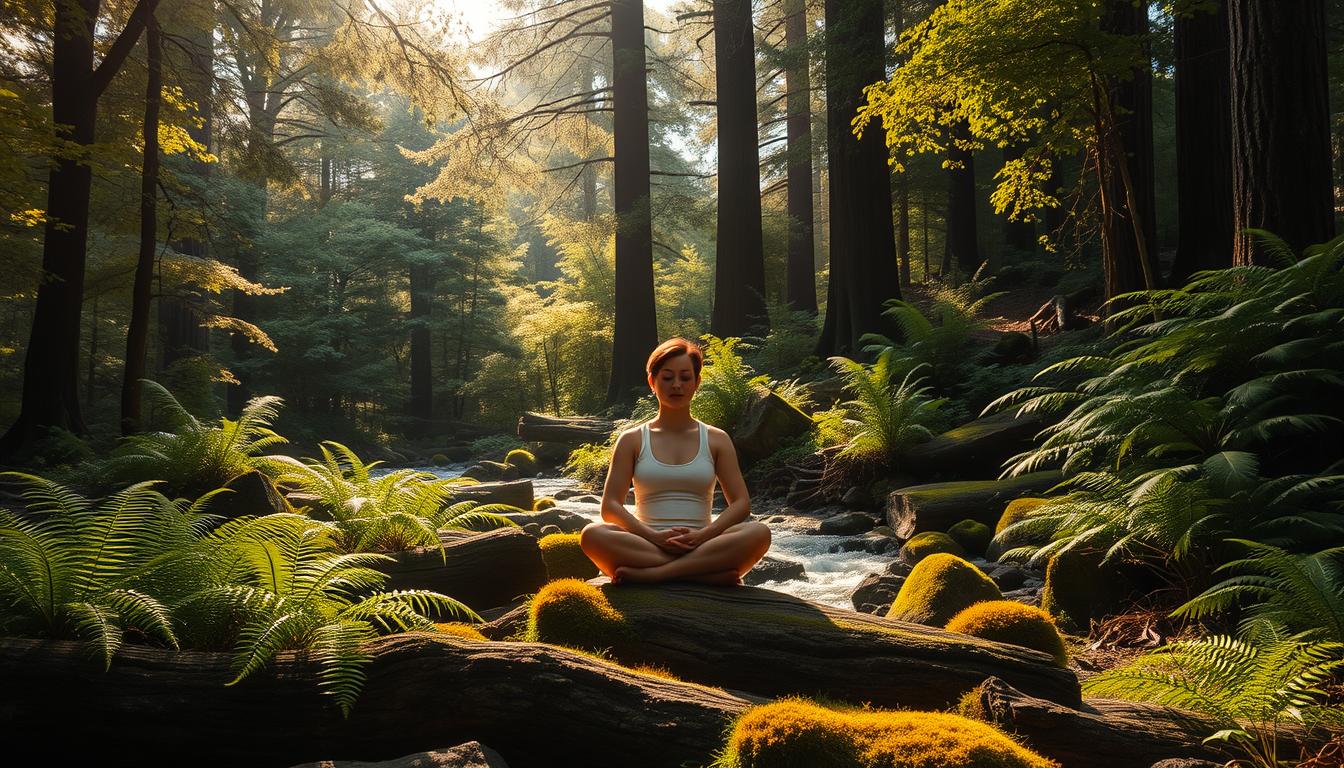Ever felt like your workouts make you stronger but don’t connect you with your body’s full power? Pilates for beginners is more than just exercise. It’s a way to link movement with mindfulness. It’s perfect for those new to fitness or looking for a change.
This method builds core strength and calms the mind. Imagine moving with purpose, feeling each stretch, and finding balance you never knew you needed.
Pilates goes beyond what traditional workouts offer. It’s not just about burning calories. It’s about reconnecting with how your body moves.
Beginners often feel their muscles working together for the first time. Every session is a chance to breathe, focus, and grow stronger, both mentally and physically.
Key Takeaways
- Pilates combines physical strength with mental focus for holistic health.
- Beginners can build core stability and posture without advanced experience.
- It’s designed to improve body awareness and reduce stress through mindful movement.
- Pilates for beginners adapts to all fitness levels, making it accessible and inclusive.
- This practice fosters long-term transformation by prioritizing quality over intensity.
What Is Pilates: Understanding the Fundamentals
Pilates is a practice that strengthens muscles, boosts flexibility, and improves overall health. It started in the early 1900s. This method combines controlled movements with focused breathing for a holistic fitness approach. Let’s dive into its history and core principles.
The History and Philosophy Behind Pilates
Joseph Pilates, a German immigrant, created Pilates during World War I. He called it “Contrology,” focusing on control and unity of body and mind. Pilates believed a strong core and proper alignment prevent injuries and increase energy. His philosophy values quality over intensity, a key principle today.
How Pilates Differs from Other Exercise Methods
Pilates uses precise, low-impact movements to target deep muscles. It focuses on form, not just how many times you do an exercise. This makes it different from weight training or cardio. The mental focus required in Pilates sets it apart, needing your full attention during each exercise.
The Six Core Principles of Pilates
- Centering: Aligning the body’s core, the “powerhouse.”
- Concentration: Maintaining full mental engagement.
- Control: Executing movements with precision.
- Precision: Ensuring every motion is exact and deliberate.
- Breathing: Coordinating breath with movement for efficiency.
- Flow: Creating smooth, rhythmic transitions between exercises.
These principles are the base of every Pilates session. They ensure safe and effective practice. By mastering them, beginners can build strength and awareness right from the start.
Why Pilates Has Become a Global Fitness Phenomenon
Pilates has become a worldwide fitness sensation, with millions embracing its holistic approach to health. It’s accessible for all ages and fitness levels. Now, over 150,000 studios exist globally, with pilates classes growing by 30% in the last decade.
Data shows 75% of practitioners report improved core strength and posture within six months. Here’s why it’s here to stay:
- Science-backed results: Studies from the Journal of Bodywork & Movement Therapies confirm its role in injury prevention and muscle balance.
- Professional endorsements: Physical therapists and athletes increasingly recommend Pilates for rehabilitation and performance.
- Social media impact: Platforms like Instagram and YouTube have fueled awareness, with #Pilates trending in 45 countries.
| Year | Global Studios | Class Attendees (Millions) |
| 2010 | 30,000 | 12 |
| 2023 | 150,000 | 58 |
“Pilates’ adaptability makes it a universal fitness solution. It’s not just exercise—it’s a lifestyle.” — Dr. Jane Smith, Sports Medicine Specialist
From celebrities to seniors, pilates attracts diverse groups seeking low-impact workouts. Its integration into gyms and online platforms ensures accessibility, making it a sustainable global trend.
The Remarkable Benefits of Pilates for Beginners
Pilates is a game-changer, focusing on your whole well-being. It’s not just about getting fit; it also helps your mind and body heal. It’s perfect for anyone, no matter your fitness level.
Physical Benefits: Strength, Flexibility, and Posture
Pilates makes your core stronger, improving balance and stability. Exercises like the “hundred” and “swimming” work deep muscles. This boosts your functional strength.
Flexibility grows with controlled stretches. Your posture also gets better as weak muscles are strengthened. A 2020 study in the Journal of Bodywork and Movement Therapies found a 15% better spinal alignment after 12 weeks.
Mental Benefits: Stress Reduction and Mindfulness
“Pilates teaches you to breathe deeply, calming the mind and lowering cortisol levels.”
- Focus on breathwork reduces anxiety and sharpens concentration.
- Mind-body connection enhances mental clarity and emotional resilience.
- Regular practice improves sleep quality by 30%, per a 2022 survey by the Pilates Method Alliance.
Rehabilitative Benefits: How Pilates Supports Recovery
Pilates was made for healing. It’s used to treat back pain, joint stiffness, and help after surgery. Low-impact moves like the “spine stretch” help restore mobility.
Leading clinics like the Rothman Institute recommend it for knee or shoulder surgery recovery.
Getting Started: What You Need to Know Before Your First Pilates Session
Starting with pilates for beginners is a thrilling step towards getting stronger and more flexible. Prepare both your body and mind for the best experience. Here’s what you need to do to succeed.
- Wear breathable, form-fitting clothes that let you move freely (like leggings or fitted tops).
- Choose light shoes or go barefoot. This helps you feel the ground better.
- Don’t forget a water bottle and a small towel for sweat.
Setting Realistic Expectations and Goals
“Progress in Pilates is like planting a seed—it grows with time and care.”
Results in Pilates come over time, not overnight. Aim for small wins like better posture or stronger core. Write down 1–2 goals, like mastering a specific exercise or improving shoulder flexibility.
Preparing Your Mind and Body
- Get there 10 minutes early to meet the instructor and share your health history.
- Drink water and have a light snack 1–2 hours before class.
- Practice deep breathing to calm your nerves.
Every Pilates expert began as a beginner. Start with curiosity, not the need to be perfect. Small steps today will lead to big changes later.
Essential Pilates Exercises for Complete Beginners
Learning the basics of pilates exercises is vital for building strength and technique. These exercises focus on engaging your core and breathing correctly. They are the foundation of any good pilates workout. Start slow, pay attention to your form, and don’t rush.
- The Hundred
- Lie on your back, lift legs to a 45-degree angle, and pump arms forcefully. Inhale for 5 counts, exhale for 5 counts, repeating 10 times. Keep shoulders grounded and ribs closed to protect the lower back.
- Roll-Up
- Sit tall, then fold forward one vertebra at a time, rolling down slowly. Reverse the motion by curling up like a spring. Common mistakes include using momentum instead of abdominal control.
- Single Leg Circles
- Lie on your back, extend one leg to the ceiling. Circle it 5 times clockwise and counterclockwise. Anchor the pelvis to prevent hip shifting. Switch legs and repeat.
- Spine Stretch Forward
- Sit with legs extended. Reach forward, rounding the spine as you fold. Keep knees straight but not locked. Inhale to lengthen, exhale to deepen the stretch.
Practice these movements 2-3 times weekly, focusing on precision over repetition. A certified instructor can help correct alignment early on. Consistency with these exercises strengthens your core, improves posture, and sets the stage for advanced moves.
Mat vs. Reformer: Choosing the Right Pilates Style for You
When deciding between mat and reformer Pilates, it’s important to understand the role of pilates equipment. Both styles aim to build strength, but they use different tools. This guide will help you choose the right method for your goals and comfort level.
Mat Pilates: Basics and Benefits
Mat Pilates uses just a yoga mat and your body weight. It’s perfect for beginners who want to build core strength without complex pilates equipment. Classes focus on foundational moves like the hundred and roll-up.
This style helps you develop control and stability. It’s a great starting point for anyone new to Pilates.
Reformer Pilates: What to Expect
Reformer Pilates introduces the iconic reformer machine—a sliding platform with springs. This pilates equipment offers resistance and support. Sessions focus on improving alignment and controlled movements.
The reformer’s springs guide you through exercises. It’s popular for those seeking precise guidance.
Other Pilates Equipment You May Encounter
- Cadillac: A tall apparatus with a padded base and springs, used for advanced flexibility work.
- Chair: A low platform for exercises targeting endurance and coordination.
- Barrels: Rounded props for spinal mobility and deep core engagement.
These tools are introduced gradually in studios. Often, they’re introduced after mastering the basics. Always ask instructors about unfamiliar pilates equipment to ensure safety and effectiveness.
Finding the Perfect Pilates Classes Near You
Choosing the right pilates studio and pilates instructor is key. Start by looking at local options. See what fits your goals.
What to Look for in a Quality Pilates Studio
- Clean facilities with well-maintained equipment
- Transparent pricing and class schedules for pilates classes
- Beginner-friendly environments with small class sizes
Read reviews and visit the studio. See its energy and if instructors are available.
Questions to Ask When Choosing a Pilates Instructor
- Do you hold a certification from a recognized Pilates organization?
- How many years of teaching experience do you have?
- How do you adapt sessions for new students?
A good pilates instructor focuses on safety and personal guidance.
Group Classes vs. Private Sessions: Which Is Better for Beginners?
| Group Classes | Private Sessions |
| Cost-effective and social | One-on-one attention and customized plans |
| Less personalized feedback | Higher cost |
| Great for building confidence in a supportive group | Ideal for overcoming specific challenges |
Beginners might start with group pilates classes. Then move to private sessions for more advanced needs.
Creating Your Home Pilates Workout Routine
Starting a home pilates workout routine is easy. You need little space and no special gear. Just clear a small area, use a good mat, and add props like resistance bands or small balls for fun. Aim to do it regularly, even if it’s just for a few minutes.
- Essentials: Yoga mat, comfy clothes, optional props
- Time: 15- to 45-minute sessions, 2-3 times a week
- Goal: Get stronger, more flexible, and move with awareness
Start with warm-ups like the Roll-Up and Spine Stretch. Then, do core exercises like the Hundred and Plank series. Finish with stretches like the Saw and Shoulder Bridge. Here’s a 30-minute routine to try:
- Warm-Up (5 mins): Cat-Cow, Rolling Like a Ball
- Core Work (15 mins): Teaser, Sidekick Series
- Cool-Down (10 mins): Mermaid Stretch, Swan
“Consistency over perfection keeps progress moving.”
Use apps like Pilates Anytime or Blogilates for guided workouts. Focus on doing it right, not how hard you’re doing it. As you get stronger, change your routine. Add mindful breathing for the best results. A home practice lets you set your own pace and focus.
Common Mistakes Beginners Make and How to Avoid Them
Starting pilates for beginners is exciting, but mistakes can slow you down. Knowing these common errors helps you stay on track for safe, effective workouts.
Form and Alignment Issues
Many new practitioners let form slip during moves like the hundred or spine stretch. Common errors include:
- Lower back arching: Tuck pelvis slightly and press lower ribs down.
- Neck strain: Gaze forward, not up, to keep cervical spine neutral.
- Shoulder hunching: Roll shoulders down and back before starting each exercise.
Breathing Techniques
Proper breathing is key—holding breath or shallow chest breathing reduces core engagement. Focus on lateral rib expansion: Place hands on ribs and feel them widen as you inhale deeply through the nose, exhaling fully through the mouth during exertion.
Progression Pitfalls
Rushing to advanced moves before mastering basics is a major setback. Avoid these traps:
- Skipping warmups: Spend 5 minutes on cat-cow or rolling like a ball before complex exercises.
- Ignoring quality over quantity: Perform 3 perfect reps instead of 10 half-hearted ones.
- Comparing progress: Track personal improvements, not others’ routines.
Regular check-ins with a certified instructor can spot issues early. Prioritizing precision builds habits that make pilates for beginners both safe and rewarding.
How to Track Your Pilates Progress: Beyond the Physical Changes
Tracking Pilates progress is more than just looking at the numbers. The benefits of pilates also touch on mental and daily life improvements. Focus on three main areas: physical, functional, and mental changes.
Look for physical signs like stronger core or better flexibility. For example, can you hold a plank longer or touch your toes more easily? Keep a journal to track these changes each week. Take photos of your posture or balance to see how you’ve improved over time.
- Measure functional progress: Notice if carrying groceries feels easier or if sitting at a desk no longer causes stiffness.
- Track mindfulness milestones: Journal moments of reduced stress or improved focus during daily tasks.
- Use apps like MindBody or Peloton Digital to log workouts and mental notes.
Progress isn’t always easy to see. Celebrate small victories like deeper breathing or better sleep. These small wins show the wide range of benefits of pilates. They prove how Pilates can improve your overall well-being. Regular checks help keep your practice goals in line with your health goals.
Incorporating Pilates into Your Existing Fitness Regimen
Adding Pilates to your routine can make you stronger and more flexible. It won’t clash with your other workouts. Here’s how to mix it in smoothly:
Pilates and Cardio: The Perfect Combination
Pair pilates workout with cardio to up your endurance game. Try these tips:
- Do a 20-minute pilates core routine before a run to stabilize hips and knees.
- Use pilates stretches post-cardio to reduce muscle tightness.
Pilates for Athletes: Sport-Specific Benefits
Top athletes use pilates to get better at their sport. It targets specific needs:
| Sport | Pilates Benefits |
| Swimming | Shoulder mobility drills for stroke efficiency |
| Golf | Rotational core work for swing power |
| Team Sports | Proprioception exercises to prevent injuries |
Creating a Balanced Weekly Schedule
Here’s a weekly plan for general fitness:
| Day | Workout |
| Monday | Strength training + 15-min pilates core flow |
| Wednesday | Cardio session followed by pilates stretching |
| Friday | Full pilates workout for recovery |
Customize it to fit your goals, and don’t forget rest days for recovery.
Conclusion: Embracing the Pilates Journey for Long-Term Transformation
Pilates for beginners lays a solid base for lasting change. It focuses on core strength, breath, and alignment. This approach offers more than quick fixes—it creates a lasting path to better health.
Starting on a mat or reformers, the focus on control and precision ensures safe progress. Beginners often notice better posture and less tension in just weeks. With time, regular practice boosts athletic performance, injury resilience, and mental clarity.
Studios like Balanced Body and Merrithew have certified instructors who tailor sessions to your needs. This makes Pilates fit for every stage of life.
Start by looking for local classes or home workouts. Use tools like foam rollers or resistance bands to deepen your practice. Tracking your progress with photos or flexibility tests shows growth beyond the scale.
Remember, Pilates rewards patience. Small efforts lead to big changes. Invest in finding an instructor who matches your goals. Whether you’re focusing on rehab, strength, or mindfulness, Pilates offers tools for balance.
Commit to regular sessions, and let Pilates evolve with you. Your journey begins now. Choose a studio, gather equipment, or follow online guides. The path to lifelong wellness starts with one mindful movement.
FAQ
What are the main benefits of Pilates for beginners?
Pilates offers many benefits for beginners. It improves core strength and flexibility. It also helps with posture and body awareness. Plus, it promotes mindfulness and reduces stress.
Do I need special equipment for Pilates classes?
Some Pilates classes use equipment like reformers or resistance bands. But, mat classes are common. For these, you just need a mat and maybe some blocks or water bottles.
How often should beginners practice Pilates to see results?
Beginners should aim for 2 to 3 Pilates sessions a week. This helps build strength, flexibility, and endurance over time.
What should I wear for my first Pilates class?
Wear clothes that fit well and let you move freely. Avoid loose clothes that might get in the way. Some people prefer to go barefoot, but grip socks are also popular.
Is Pilates suitable for people with injuries or specific health conditions?
Yes, Pilates is great for people with injuries or health issues. It focuses on controlled movements that can be adjusted for different needs. Always talk to a doctor or instructor before starting.
Are group classes better or worse than private sessions for beginners?
Group classes offer motivation and community, while private sessions provide personalized attention. Beginners might find it helpful to start with private sessions to learn the basics.
What should I focus on during my Pilates practice?
Pay attention to the six core Pilates principles: concentration, control, centering, flow, precision, and breathing. These help improve your workout and balance.
How can I find qualified Pilates instructors near me?
Look for instructors with recognized certifications and experience with beginners. Check out reviews and visit studios to see if they feel welcoming.
Can I practice Pilates at home, and what do I need?
Yes, you can do Pilates at home! You’ll need a good mat and maybe some props like resistance bands. Online classes and videos can guide you.
How can I track my progress in Pilates?
Track your progress by noticing physical changes like better flexibility and core strength. Also, pay attention to how your posture and overall feeling improve. Keeping a journal or using fitness apps can help.


